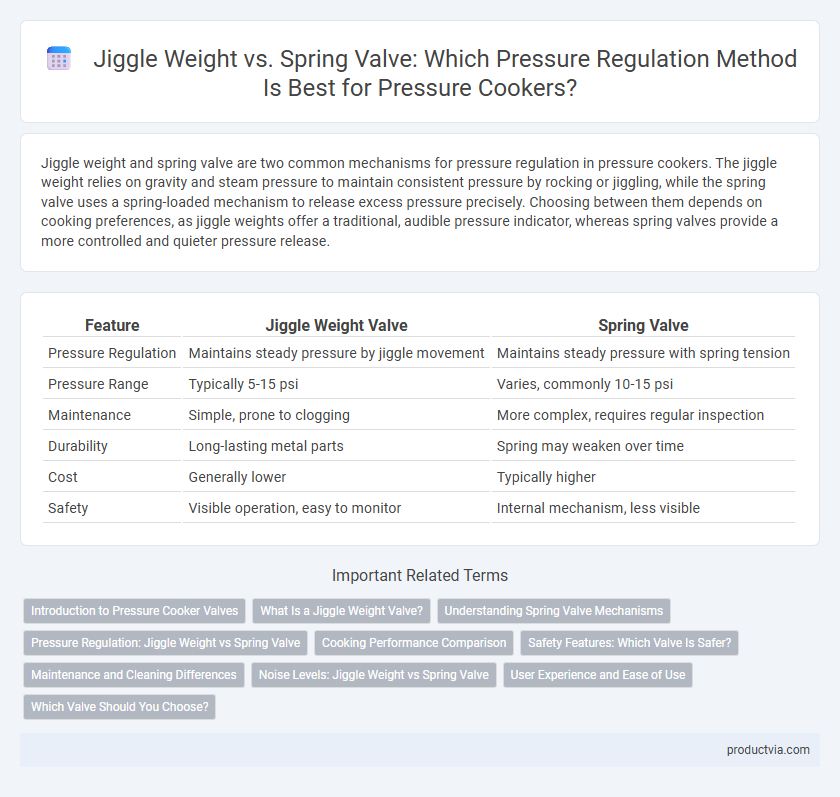Jiggle weight and spring valve are two common mechanisms for pressure regulation in pressure cookers. The jiggle weight relies on gravity and steam pressure to maintain consistent pressure by rocking or jiggling, while the spring valve uses a spring-loaded mechanism to release excess pressure precisely. Choosing between them depends on cooking preferences, as jiggle weights offer a traditional, audible pressure indicator, whereas spring valves provide a more controlled and quieter pressure release.
Table of Comparison
| Feature | Jiggle Weight Valve | Spring Valve |
|---|---|---|
| Pressure Regulation | Maintains steady pressure by jiggle movement | Maintains steady pressure with spring tension |
| Pressure Range | Typically 5-15 psi | Varies, commonly 10-15 psi |
| Maintenance | Simple, prone to clogging | More complex, requires regular inspection |
| Durability | Long-lasting metal parts | Spring may weaken over time |
| Cost | Generally lower | Typically higher |
| Safety | Visible operation, easy to monitor | Internal mechanism, less visible |
Introduction to Pressure Cooker Valves
Pressure cooker valves regulate internal pressure by controlling steam release, with jiggle weights and spring valves being the primary types. Jiggle weights use a weighted disk that physically lifts and jiggles to maintain pressure, offering a simple, reliable steam venting method. Spring valves utilize a calibrated spring mechanism to open at set pressure levels, providing precise and consistent pressure control in modern cookers.
What Is a Jiggle Weight Valve?
A jiggle weight valve is a type of pressure regulator used in pressure cookers that maintains consistent pressure by releasing steam through a weighted, movable metal piece. This valve jiggles or rocks at a specific pressure level, allowing excess steam to escape and preventing over-pressurization. Unlike spring valve mechanisms, the jiggle weight relies on gravity and weight to regulate pressure, offering a simple and reliable method for home pressure cookers.
Understanding Spring Valve Mechanisms
Spring valve mechanisms in pressure cookers regulate internal pressure by compressing a spring to release steam when a preset pressure level is reached. Unlike jiggle weight valves that rely on oscillating weights to maintain pressure, spring valves offer precise control through calibrated spring tension, ensuring consistent cooking performance. Understanding spring valve dynamics enhances safety and efficiency by preventing excessive pressure buildup during cooking.
Pressure Regulation: Jiggle Weight vs Spring Valve
Jiggle weight pressure cookers regulate pressure using a weighted valve that gently rocks or jiggles to release excess steam, maintaining a consistent pressure level typically around 15 psi. Spring valve pressure cookers employ a spring-loaded mechanism that lifts to release steam once the set pressure is reached, offering precise pressure control and faster response to pressure changes. While jiggle weight valves provide a visual indication of pressure and simpler maintenance, spring valves deliver more accurate pressure regulation and often enhanced safety features.
Cooking Performance Comparison
Jiggle weight valves provide consistent pressure release through their weighted design, resulting in steady cooking temperatures ideal for slow-cooked recipes, while spring valves offer more precise pressure control with quicker pressure adjustments suitable for delicate or varied cooking tasks. Cooking performance with jiggle weights tends to be more stable under heavy loads, ensuring thorough heat retention, whereas spring valves excel in responsiveness, reducing cooking time and improving safety. Pressure cooker efficiency depends on the choice between the durability and simplicity of jiggle weights versus the versatility and accuracy of spring valves, impacting overall meal results.
Safety Features: Which Valve Is Safer?
Jiggle weight valves offer a visible indicator through their bouncing motion, providing immediate feedback that pressure is maintained safely within the cooker, which enhances user awareness and safety. Spring valves, while more compact and often faster to respond, rely on internal mechanisms without external movement cues, potentially making it harder for users to detect pressure levels visually. Overall, jiggle weight valves are considered safer because their clear, visual pressure regulation reduces the risk of overpressure accidents during cooking.
Maintenance and Cleaning Differences
Jiggle weight valves require minimal maintenance due to their simple design, with occasional cleaning needed to remove food debris that can block the valve's movement. Spring valves involve more complex mechanisms that can trap residue in the spring, necessitating regular disassembly and thorough cleaning to maintain pressure accuracy. Proper maintenance of both valve types ensures consistent pressure regulation and extends the pressure cooker's lifespan.
Noise Levels: Jiggle Weight vs Spring Valve
Jiggle weight pressure cookers produce a distinctive rhythmic noise due to the weighted valve lifting and dropping to release steam, which can be louder compared to spring valve models. Spring valve cookers maintain pressure more quietly by using a spring mechanism to regulate steam release without repetitive valve movement. Noise levels in pressure cookers impact user comfort, with spring valves offering a quieter cooking experience preferred in noise-sensitive environments.
User Experience and Ease of Use
Jiggle weight valves offer a clear visual indicator of pressure, enhancing user confidence and control during cooking, while requiring minimal maintenance and straightforward operation. Spring valves provide precise pressure regulation and often operate quietly, appealing to users seeking a low-noise experience without frequent adjustments. Both mechanisms contribute to safety and efficiency, but jiggle weight valves are generally favored for their simplicity and immediate pressure feedback.
Which Valve Should You Choose?
Jiggle weights provide a visual indicator of pressure by rocking or jiggle on the valve, making it easy to maintain consistent pressure levels in traditional stovetop pressure cookers. Spring valves use a spring mechanism to automatically regulate pressure and maintain precise settings, often found in modern electric models for improved safety and control. Choose jiggle weight valves for simplicity and classic stovetop use, while spring valves offer more accurate pressure regulation and convenience in electric pressure cookers.
Jiggle weight vs spring valve for pressure regulation Infographic

 productvia.com
productvia.com